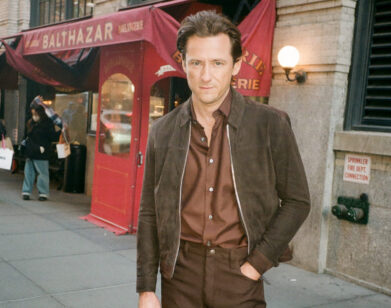Nicholas Hytner and Alan Bennett’s Guest

ABOVE: DAME MAGGIE SMITH AND ALEX JENNINGS AS MISS SHEPARD AND ALAN BENNETT IN THE LADY IN THE VAN. PHOTO COURTESY OF SONY PICTURES CLASSICS.
In the mid-70s, playwright Alan Bennett allowed an elderly woman living in a yellow van to park in his driveway. Known as Miss Shepard, she stayed there for 15 years. She was never grateful or gracious. When other residents of Bennett’s street (Gloucester Crescent in Camden, London) tried to engage her in conversation or offer her gifts, she was recalcitrant at best.
Throughout her residence, Bennett questioned his motives for letting her stay: weakness, morbid curiosity, guilt at neglecting his own mother. “Alan would absolutely deny that he felt an emotion called compassion,” says director and frequent Bennett collaborator Nicholas Hytner. “Any good turn he did her was accompanied by a desire to strangle her. He hated being called nice, he hated being called kind, and she took advantage of him. But at the crucial moment, when the police were going to move her along, he said ‘Why don’t you stay.'”
Whatever Bennett’s relationship with his neighbor, she had a lasting effect on him. After her death, he published a memoir about the experience first in the London Review of Books and then as book. In 1999, Bennett’s play The Lady in the Van debuted at the Queen’s Theatre in London, directed by Hytner and starring Dame Maggie Smith as Miss Shepard. Earlier this year, a film adaptation reuniting Smith, Hytner, and Bennett (as the screenwriter) premiered at the Toronto International Film Festival. “Nobody can remember why we didn’t do the film 15 years ago,” says Hytner. “I think a lot of people will recognize what we all wish ourselves to be in that act of hospitality. People want to be basically civilized, kind, and hospitable, even if they moan.”
For the last 20 years, the Cambridge-educated Hytner has been one of the most sought after theater and opera directors in London and New York (his most recent play on Broadway was the hugely successful farce One Man, Two Guvnors). He’s collaborated with Bennett numerous times and, during his 12-year tenure as director of the National Theatre in London, directed Bennett’s The History Boys (2004) and The Habit of Art (2009). (Fun fact: every living member of the original History Boys cast makes a cameo in The Lady in the Van, from James Corden to Dominic Cooper to Stephen Campbell Moore.) Now, he’s working on a new theater for his company the London Theatre Company.
EMMA BROWN: Did you know about Miss Shepard when you lived in Camden in the ’80s?
NICHOLAS HYTNER: I had no idea what was going on. I’ve lived in Camden since 1981 and I knew who lived on Gloucester Crescent, and I knew where Alan Bennett lived. I used to walk down it quite a lot; it was one of the ways to the tube. I would see this grotesque yellow van and quite often this old lady around it. I knew that was Alan’s house, but I had no idea what was going on. I honestly thought, “Is that his mother? Does he keep his mother in a van outside?” It was only about six months after she died that I worked with Alan for the first time. I never said, “What was that van?” I found out later that nobody ever said, “What was that van?” Even people who visited him while the van was there—and you had to squeeze past it to get in. People were just too polite. Then in 1990, he wrote a memoir of it. I found out about it along with everybody else. I did see her. I never spoke to her. She was scary. Several of the people involved in the movie did know her, did speak to her. Frances de la Tour did. Jim Broadbent did. The composer Jim Fenton, who’s known Alan for quite a long time, used to try to have conversations with her, but that wasn’t easy.
BROWN: I read that you actually filmed in Alan’s old house.
HYTNER: Yes, that’s the actual house. Everything looks exactly as it did. The study looks the same as it did. We brought back all his books. He still owns the house; there’s a tenant in it who kindly vacated for a couple of months. The drive is the same. The vans are exact copies of what she had.
BROWN: That must have been quite a strange experience for Alan. Did he come to set often?
HYTNER: Yeah, he was there most days. I think it was. It’s a very particular street, it was a kind of colony for North London liberal artists and intellectuals. It wasn’t just Alan; it was other writers, directors, journalists, novelists. Steven Frears’ first wife lived there so he was there an awful lot and he knew her. He passed by the set one day and asked what we were up to, and he said, “I’m not coming to see that! I knew the real thing. I’m not paying money to see her all over again.” They all bought the houses in the ’60s when they were cheap, and a lot of them are still there. But quite sweet is that a lot of the children, who remember her very well and are now in their 40s and 50s, came by while we were shooting. They were full of stories about her—how they used to torment her and she used to torment them and they were terrified by her. There’s a little scene in the film where they bring her Christmas presents, and she tells them to shut the door and never says thank you. That was not in the script. That was literally somebody I know who was a kid when she was there who said to me, “I remember our parents used to make us take Christmas presents to her every year and we’d knock on the door of the van, give her presents, and she just used to tell us to get lost. She’d take the presents and tell us to get lost.” I thought, “That’ll take a couple of hours to shoot that little scene,” so we just put it in. A lot of it was memory that was being recreated almost at the moment it was being remembered.
BROWN: But she never says thank you to anyone.
HYTNER: Not at all. Never did. It’s one of the magnificent things about her. This is not a likeable character, but what makes her magnificent and likeable is her determination—a strong-willed determination to live the life she’s going to live. Even though she’s at the bottom of the heap, nobody’s going to tell her otherwise. They never exchange an affectionate word, but I think that’s what makes it very particular.
BROWN: I was wondering about how this situation would play out today, when you can just Google people and find out everything about them.
HYTNER: Alan couldn’t, not even now. He knew only what she told him. She was not giving him her real name. Maybe social services would know more about her. He’s very scrupulous and argues himself throughout the film—as I think he must have argued with himself right through the 15—he argues about what is permissible to speculate, what is permissible to write that isn’t true, and how far is he allowed to depart from the gospel truth. The gospel truth is he found out a great deal of what he knew about her after she died. He met her brother after she died. He found out about the accident after she died from a priest at a church she used to go to, to whom she must have talked about it outside of the confessional or the priest would never have said. So I think there’s nothing about her that you could find online. Not even now.
BROWN: When you first met Alan, did you get on right away?
HYTNER: Yeah, we got on fine. But I think we created a working relationship by working. It was by doing the first play that we discovered how well we got on and that was what made him give me The Madness of George III. I have always so responded to the way he writes, the way he looks at the world, his outsider status, the way he uses the language. He claims that he has no vivid imagination and has always, I think, looked to me for what he imagines he can’t do himself. I think he can probably do it pretty well. So we’ve created a working relationship over 25 years.
BROWN: There are two Alan Bennetts in the film and the play—Alan Bennett the writer and Alan Bennett the layman. In the play, they were played by two different actors. In the film, they’re both played by the same actor. Do you feel like having just one actor as Bennett took away or added something to the part?
HYTNER: I think that would have been too theatrical a device. It is much easier than it was 15 years ago to have the same actor twice in the same frame. There was no point in thinking of doing it any differently. We wanted to retain that device [of two Bennetts]. It is truthfully how he feels and sees himself; he’s always thought that the writer part of him is bolder than the one, as he says, who does the living. He’s always said the writer is less scrupulous and more ruthless than the one who does the living. There’s something quite truthful about that device. It’s obviously not literal reality, but one of the things he learns during the film is to stop being scrupulous and to start allowing his imagination free reign. By the end of the film, he’s allowing her to write her own ending. Although huge care has been taken to make everything look exactly the way it looked right from the start, it’s also a writer’s response to how things were. It’s not the actual, literal, mundane truth.
BROWN: You’ve directed so many plays over the course of your career. What makes you think a play is worth taking to the screen—that you will get something new out of it?
HYTNER: It’s Alan’s stuff. I can’t imagine wanting to make a movie in the forseeable future that isn’t Alan’s stuff. There are people who do it better than me. I’m a theater director. I feel that, when it’s Alan’s sensibility and Alan’s stories, I can bring something to it because of my long experience with him that’s worth coming away from the theater for. There are very few people who are as good in both mediums—very, very few. I’m certainly not equally confident, or equally adept.
BROWN: I heard people squatted in the van while you were filming.
HYTNER: It’s true. One horrific Monday morning…Camden is a big party place, so two people had rolled out of some club in the early hours of Sunday morning—a couple—and taken up residency in the van outside the house. Monday morning at five o’clock, when the props people arrived to start putting the set back together again, they opened the door and these two bleary young people came staggering out. They were high on all sorts of god-knows-what and the props people were terrified. They thought, “God knows what’s been going on in here.” The whole of the contents of the van were taken out, deep-cleaned, and then made dirty again and brought back. We had to pretend to Maggie that something else was going on, because we were due to shoot her coming out of the van first thing and nobody there would admit to her what had been going on. I did admit to her a few months later and she thought it was very funny. There were a couple of disreputable clubbers having a very good time inside that van.
THE LADY IN THE VAN IS OUT NOW IN NEW YORK AND L.A. IT WILL EXPAND ITS RELEASE ON JANUARY 15, 2016.






